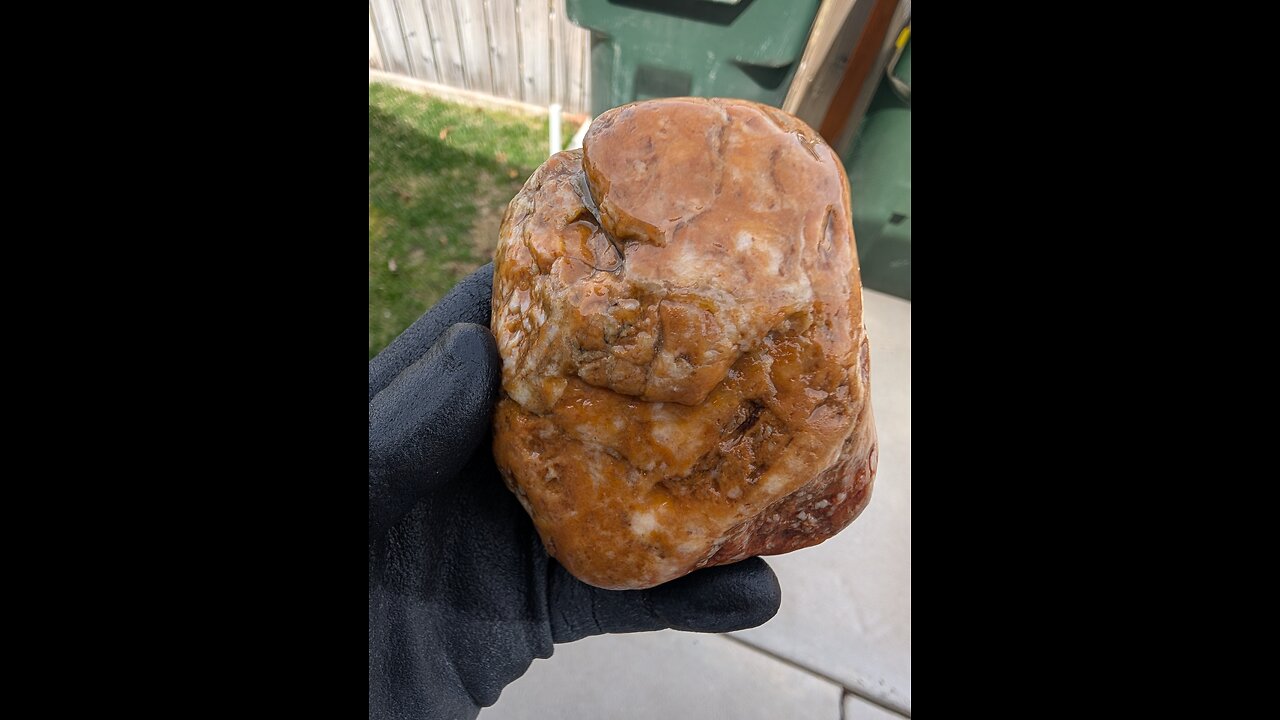Premium Only Content

The rock in the image appears to be a type of agate, likely a variety known as carnelian agate or a similar chalcedony-based stone. Here's why:
Color and Appearance: The rock has a translucent to semi-translucent quality with a mix of warm orange, brown, and white hues. Carnelian, a type of chalcedony, often exhibits these colors, ranging from pale orange to deep reddish-brown. The white patches could be due to inclusions or banding, which is common in agates.
Texture and Luster: It looks smooth and has a waxy to glassy luster, typical of chalcedony minerals like agate. The surface appears polished, either naturally or by human intervention, which is common for agates used in jewelry or collections.
Banding: Agates often have concentric banding or layering, and while the banding isn’t extremely pronounced in this specimen, the variations in color suggest some layering, which is a hallmark of agate formation.
What is Agate/Chalcedony?
Agate is a variety of chalcedony, which itself is a microcrystalline form of quartz (SiO₂). It forms in volcanic or sedimentary environments, often in cavities or voids where silica-rich fluids deposit layers over time, creating the characteristic banding. Carnelian specifically is valued for its warm tones and is often associated with iron oxide impurities that give it the orange-to-red coloration.
Other Possibilities
While carnelian agate is a strong candidate, there are a couple of other possibilities:
Jasper: Jasper is another form of chalcedony but is typically more opaque and lacks the translucency seen here. However, some jasper varieties can have similar colors.
Marble or Calcite: Some types of marble or calcite can have a similar appearance, especially with orange and white coloring, but they usually lack the waxy luster and translucency of chalcedony. Calcite also tends to be softer (Mohs hardness of 3) compared to chalcedony (Mohs hardness of 6.5–7).
How to Confirm
To be more certain, you could:
Hardness Test: Chalcedony has a Mohs hardness of 6.5–7, so it should scratch glass but not be scratched by a steel knife.
Translucency Test: Hold it up to a light source. Agates often show some translucency, especially in thinner sections.
Streak Test: Chalcedony typically leaves a white streak when scratched on an unglazed ceramic tile.
-
 1:01:59
1:01:59
Candace Show Podcast
3 hours agoEXCLUSIVE! Another Photo Of Tyler Robinson | Candace Ep 238
76.9K187 -
 2:21:09
2:21:09
Redacted News
4 hours agoWhat are they hiding? New video evidence in Charlie Kirk's Shooting SHAKES FBI'S case | Redacted
144K279 -
 41:53
41:53
Kimberly Guilfoyle
6 hours agoCharlie's Legacy and Our Mission
42.4K8 -
 1:07:55
1:07:55
vivafrei
5 hours agoJimmy Kimmel Out Indefinitely! Trump "Srubs" Study on Right Wing Violence? Clinton Tweet & MORE
206K80 -
 1:35:02
1:35:02
The Quartering
6 hours agoNuclear Fallout From Jimmy Kimmel Firing, New Head Of TP USA, Obama Whines
231K75 -
 23:35
23:35
Jasmin Laine
4 hours ago“We Were Betrayed”—Carney HUMILIATED As His Base REVOLTS Against Him
40.7K25 -
 LIVE
LIVE
LFA TV
21 hours agoKIMMEL GONE | ANTIFA LABELED TERRORISTS! - THURSDAY 9/18/25
755 watching -
 2:21:28
2:21:28
freecastle
8 hours agoTAKE UP YOUR CROSS- Hope In GOD, and Fear NO Evil!
20.4K9 -
 1:34:10
1:34:10
The HotSeat
5 hours agoChapter 32 Begins: Honoring Charlie Kirk’s Legacy & Jimmy Kimmel Gets Canceled
27.7K9 -
![[Ep 751] Jimmy Kimmel – You’re Fired! | Freedom of Speech is Not Freedom From Consequence](https://1a-1791.com/video/fww1/bd/s8/1/e/-/h/j/e-hjz.0kob-small-Ep-751-Jimmy-Kimmel-Youre-F.jpg) 3:11:10
3:11:10
The Nunn Report - w/ Dan Nunn
5 hours ago[Ep 751] Jimmy Kimmel – You’re Fired! | Freedom of Speech is Not Freedom From Consequence
33.7K7